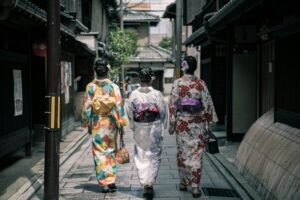Japan, a country rich in culture, history, and natural beauty, offers travelers a diverse array of experiences. From ancient temples and serene gardens to bustling cities and cutting-edge technology, Japan seamlessly blends its traditional past with modern innovation. Planning a two-week adventure allows visitors to see the best of both worlds, from the energetic streets of Tokyo to the tranquil temples of Kyoto, and the natural beauty of Hokkaido. In this guide, we’ll explore a detailed itinerary that helps you make the most of your two-week journey across this fascinating country.
Day 1-3: Tokyo – Embrace the Vibrancy of Japan’s Capital
Begin your two-week adventure in Tokyo, a city that never sleeps. Tokyo is a metropolis of neon lights, skyscrapers, and centuries-old temples. Kick off your visit in Shibuya, where you can witness the iconic Shibuya Crossing, the world’s busiest pedestrian intersection. From there, make your way to the Meiji Shrine, located in a peaceful forested area, providing a quiet retreat from the bustling city. Explore the cultural hubs of Asakusa, where you can visit Senso-ji, Tokyo’s oldest temple. Don’t miss the opportunity to wander through the lively Nakamise shopping street.
Day 4-6: Mount Fuji and Hakone – Nature and Tranquility
After three days in Tokyo, it’s time to escape the city and head to the peaceful area of Hakone. Famous for its hot springs (onsen) and close proximity to Mount Fuji, Hakone is the perfect place to unwind. Start by taking the Hakone Ropeway to Owakudani, an active volcanic valley, where you can witness steaming vents and hot springs. If the weather is clear, you’ll be rewarded with stunning views of Mount Fuji from Lake Ashi. Spend a day visiting Hakone’s open-air museums, including the Hakone Open-Air Museum, which features modern sculptures and a peaceful foot bath for relaxation. The town also offers many traditional ryokan inns where you can experience the comfort of Japanese hospitality.
Day 7-9: Kyoto – The Heart of Japanese Tradition
Kyoto, the former capital of Japan, is a must-see on your two-week journey. This city is home to over 1,600 temples, shrines, and traditional gardens. Begin by visiting the iconic Fushimi Inari Shrine, known for its thousands of vermilion torii gates that lead you up Mount Inari. Next, head to the stunning Kinkaku-ji, or Golden Pavilion, which reflects beautifully off its surrounding pond.
One of the most picturesque spots in Kyoto is the Arashiyama Bamboo Grove. As you stroll through the towering bamboo stalks, you’ll feel like you’ve stepped into another world. Nearby, visit Tenryu-ji Temple, a UNESCO World Heritage Site, and its beautiful gardens. No visit to Kyoto is complete without experiencing a traditional tea ceremony.
Day 10-11: Osaka – A Food Lover’s Paradise
Just a short train ride from Kyoto, Osaka is known as Japan’s culinary capital. The vibrant city offers some of the best street food in the country, so make sure to try local favorites like takoyaki (octopus balls) and okonomiyaki (savory pancakes). Start your Osaka adventure by visiting Osaka Castle, a historical landmark that provides insight into Japan’s feudal history. Dotonbori, Osaka’s entertainment and nightlife district, is the place to be after dark. Bright neon lights illuminate the streets, and the aroma of sizzling street food fills the air. You can also take a boat ride along the Dotonbori Canal for a unique view of the city. For an unconventional and playful stop, check out the unko museum Tokyo which is dedicated to poop-themed art and games, offering a fun and lighthearted break from traditional sightseeing. Afterward, if you’re looking for some shopping, head to Shinsaibashi and Namba, Osaka’s most famous shopping districts.
Day 12: Nara – Deer and Temples
Nara, just a short trip from Osaka or Kyoto, is famous for its friendly deer and historical temples. Spend a day wandering through Nara Park, where you can feed and interact with the free-roaming deer, believed to be sacred messengers of the gods. Visit Todai-ji Temple, home to the world’s largest bronze Buddha statue, housed in a massive wooden structure. Kasuga Taisha, another key highlight of Nara, is known for its beautiful lanterns and peaceful surroundings. Take a walk through its serene paths, lined with ancient stone lanterns that lead up to the shrine.
Day 13-14: Hokkaido – Experience the Great Outdoors
Wrap up your trip with a flight to Hokkaido, Japan’s northernmost island, known for its stunning natural landscapes. In summer, the island is a haven for hikers, with its flower fields, mountains, and national parks. Start your visit with the city of Sapporo, where you can sample fresh seafood and ramen unique to the region. Head out to Daisetsuzan National Park for a day of hiking and enjoy the breathtaking scenery of alpine meadows, waterfalls, and volcanic craters. If you visit in the winter, Hokkaido transforms into a snow-covered wonderland, perfect for skiing and snowboarding.

A two-week journey through Japan allows you to experience its diverse blend of ancient traditions and modern innovations. From the vibrant streets of Tokyo to the peaceful temples of Kyoto, and the natural beauty of Hokkaido, Japan offers something for every traveler. By carefully planning your itinerary, you can see the best of what this unique country has to offer, creating memories that will last a lifetime.



